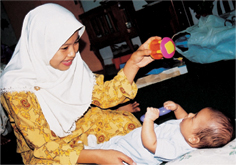All children need the affection of their parents. It is an essential part of development and adequate amounts lead to happy and healthy child-parent relationships.
The development of maternal attachment is a combination of biological processes and experience. Immediately after giving birth, the mother’s hormone levels are such that she becomes very receptive to establishing an emotional bond with her newborn. During this sensitive period, skin to-skin contact with baby allows bonding to take place.
Mothers who receive early or extended contact show more affection towards their infants, suggesting that a close emotional relationship has developed. When children engage in this interactive developmental pattern, they would eventually develop strong feelings of attachment to their parents.
This sense of attachment goes through several developmental stages which are described below. At around 8 weeks old, babies get used to their mothers and follow their movements using their eyes.
Babies also turn their eyes towards the sound of their mothers’ voices. Between 8 weeks to 6 months old, babies become attached to other people in the environment. Compared with earlier periods, being separated from their mothers does not readily result in distress provided that the infants’ needs are satisfied.
Most psychologists agree that the degree of the infants’ attachment to their mothers can first be observed at 6 to 8 months of age. This trend is driven by emotional and physical development. Where emotional development is concerned, fear begins to emerge as the main emotional reaction in babies. They begin to recognise and differentiate between what is strange or familiar. They also develop a wariness of strangers and are distressed when they are separated from their mothers. One of the clearest indications of attachment is that being close to their mothers markedly reduces babies’ distress.
Between the ages of 6 to 8 months, most babies develop their physical abilities and begin to crawl. For the first time, babies have considerable control over where they are. Thus they no longer need to rely on crying to get their mothers to pick them up for comfort. Babies need only crawl to, and follow, their mothers around.
Why Attachment is Important
Psychologist studying attachment have indicated that babies who are very attached to their mothers developed better mental health. These babies display a variety of positive characteristics, such as, being better problem solvers, being more curious, doing more exploring, being more socially competent, cooperative and obedient, and generally getting along well with peers. These babies are also less likely to develop emotional or behavioural problems.
How Do I know When I have a Good Relationship with My Child?
Given that a good relationship between parent and child leads to good mental health, many parents often wonder when this relationship is strong. Here are some things to look out for that might indicate a strong relationship.
- Your child looks up and smiles regularly at you.
- When you come home, your child would run to greet you.
- Your child would willingly give or show you things that interest or entertain him.
- Your child will regularly hug and kiss you.
- Your child would try to tell you lots of things.
- Your child would run to you for comfort when unsure of a situation.
- Your child, when old enough, would tell you secrets.
- Your child may want to regularly call you using the telephone to hear your voice.
- Your child looks forward to spending time with you.
Tips of Improving Child-Parent Relationships
The behaviours that children learn are largely modelled on their parents. When children watch and observe, they learn and the lessons are put into practice. Thus, ensuring that children develop a loving and caring relationship with their parents would require lots of interaction between them. The following are some useful suggestions on how to improve the quality of the childparent relationship.
Spend Quality Time
When spending quality time with your child, take an interest in his daily activities. When your child speaks, you need to be attentive. In addition to quality time, there are many ways to spend time doing things with your child. These activities include playing with toys at home, or reading a story to him. Through spending time and getting to know what your child does with his time, you can have a better idea of what your child’s habits are. Spending time with your child also helps because you can look out for the times when your child is distressed, and subsequently find out why he feels that way. Being able to spend at least 30 minutes of quality time daily with your child goes a long way towards strengthening your relationship with him. Remember to take part in whatever activity your child wants. It is meant to be your child’s quality time! Talk to your child, and remember to ask him how he feels.

Praise and Notice Positive Things
As humans, we are especially good at noticing and pointing out all the bad things that others have done. We often forget to notice and acknowledge the good that they are doing. This often leaves others with a good understanding of what they cannot do, but very little information on what they can do, and how well they are carrying out a task. Positive interaction with every child is important. Notice and praise your child whenever he has achieved something.You can show that you love him, but at the same time, he needs you to demonstrate that only positive behaviours will be tolerated. Be firm with your instructions. If your child has done something wrong, make sure you do what you are going to do. If you model positive behaviours towards your child, he will respond with positive behaviours towards you.
Comfort, Protect and Guide
Your child is a fragile being whose destiny is very much moulded by your impressions, expectations and reactions towards him. Thus, being there to comfort, protect and guide him is an important aspect of improving your child-parent relationship. When it comes to learning new skills, encourage, instead of forcing, your child to try new skills for a limited period of time. If it is evident that he is not enjoying the activity, drop it and move on until you find some activity that he enjoys doing. It is better to let your child have a broad buffet of activities and enjoy him, rather than force him to concentrate on one thing that he will hate for life.







Comments